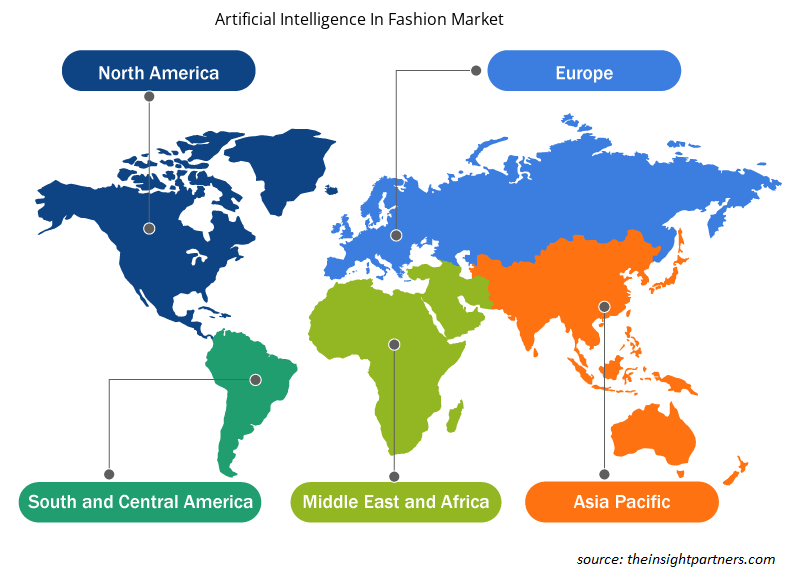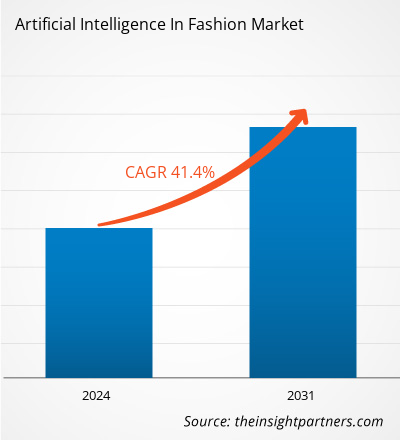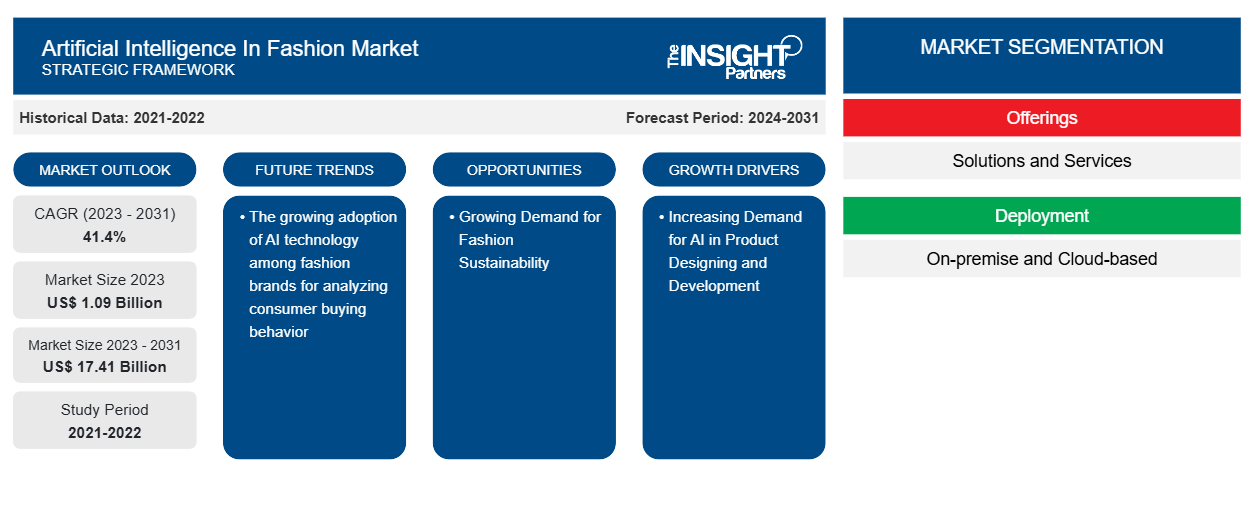من المتوقع أن يصل حجم سوق الذكاء الاصطناعي في الموضة إلى 17.41 مليار دولار أمريكي بحلول عام 2031 من 1.09 مليار دولار أمريكي في عام 2023. ومن المتوقع أن يسجل السوق معدل نمو سنوي مركب بنسبة 41.4٪ في الفترة 2023-2031. ومن المرجح أن يظل التبني المتزايد لتقنية الذكاء الاصطناعي بين العلامات التجارية للأزياء لتحليل سلوك الشراء لدى المستهلك أحد أهم أشكال الذكاء الاصطناعي في اتجاهات سوق الموضة.
تحليل سوق الذكاء الاصطناعي في مجال الأزياء
يشهد سوق الأزياء نموًا سريعًا بسبب الطلب المتزايد على الذكاء الاصطناعي في تصميم وتطوير المنتجات والطلب المرتفع من العملاء على تجربة شخصية. يتوسع السوق بشكل مطرد، مدفوعًا بالطلب المتزايد على الذكاء الاصطناعي لإدارة المخزون. علاوة على ذلك، يوفر الطلب المتزايد على استدامة الأزياء ونمو تجارة التجزئة للأزياء السريعة فرصًا مربحة لنمو السوق.
نظرة عامة على سوق الذكاء الاصطناعي في عالم الأزياء
يعمل الذكاء الاصطناعي على تحويل صناعة الأزياء من خلال تحسين العديد من مجالات دورة حياة المنتج وإعادة تعريف كيفية إنتاج الملابس وبيعها وارتدائها. توفر التكنولوجيا المتطورة قدرات تحويلية للمصممين وتجار التجزئة والمستهلكين. يستخدم مصممو الأزياء الذكاء الاصطناعي لتعظيم إمكاناتهم الإبداعية ودفع الابتكار في التصميم. قد ينتج المصممون أفكارًا جديدة ومبتكرة باستخدام خوارزميات الذكاء الاصطناعي لفحص كميات هائلة من بيانات الموضة التاريخية وتحديد الاتجاهات المحتملة في صناعة الأزياء.
تعمل أنظمة التوصية المدعومة بالذكاء الاصطناعي على تحسين تجربة شراء العملاء من خلال تقديم اقتراحات فردية للمنتجات بناءً على اهتمامات الأفراد. يدعم الذكاء الاصطناعي العلامات التجارية للأزياء في تقييم بيانات المستخدم مثل سجل التصفح وسلوك الشراء وتفضيلات الأسلوب وإنشاء اقتراحات مخصصة بناءً على أذواق واهتمامات المستهلكين. يعمل هذا التخصيص على تحسين مشاركة العملاء وبناء ولاء العلامة التجارية وزيادة تحويلات المبيعات.
قم بتخصيص هذا التقرير ليناسب متطلباتك
ستحصل على تخصيص لأي تقرير - مجانًا - بما في ذلك أجزاء من هذا التقرير، أو تحليل على مستوى الدولة، وحزمة بيانات Excel، بالإضافة إلى الاستفادة من العروض والخصومات الرائعة للشركات الناشئة والجامعات
-
احصل على أهم اتجاهات السوق الرئيسية لهذا التقرير.ستتضمن هذه العينة المجانية تحليلاً للبيانات، بدءًا من اتجاهات السوق وحتى التقديرات والتوقعات.
الذكاء الاصطناعي في سوق الأزياء: العوامل المحركة والفرص
الطلب المتزايد على الذكاء الاصطناعي في تصميم وتطوير المنتجات هو المحرك للسوق
تلعب الذكاء الاصطناعي دورًا مهمًا في تصميم وتطوير المنتجات في صناعة الأزياء. لقد قامت الصناعة بدمج أدوات مدعومة بالذكاء الاصطناعي بشكل كامل في العمليات الإبداعية لتبسيط وتحسين العديد من جوانب التصميم، وزيادة الكفاءة وتشجيع الابتكار طوال دورة حياة المنتج . يتم استخدام الذكاء الاصطناعي بشكل كبير لتحسين النمط في تصميم المنتج وتعظيم كفاءة المواد التي تقود السوق. تفحص خوارزميات الذكاء الاصطناعي معايير التصميم وصفات المواد لتطوير أنماط مثالية تقلل من النفايات مع تعظيم استخدام الموارد. تساعد التكنولوجيا أيضًا المصممين في تلبية أهداف توفير التكاليف والاستدامة البيئية مع الحفاظ على سلامة التصميم. ومن المتوقع أن تغذي هذه العوامل السوق خلال فترة التنبؤ.
الطلب المتزايد على استدامة الموضة – فرصة في سوق الذكاء الاصطناعي في الموضة
تركز صناعة الأزياء بشكل متزايد على الأساليب المستدامة والتوريد الأخلاقي للمواد. تلعب الذكاء الاصطناعي دورًا مهمًا في تسهيل اختيار المواد المستدامة للمنتجات، وتوفير رؤى حيوية ومساعدة لشركات الأزياء. تساعد خوارزميات الذكاء الاصطناعي في فحص العديد من العناصر أثناء تقييم المواد من أجل الاستدامة. تتضمن هذه العناصر إجراءات التوريد الأخلاقية، واعتبارات فعالية التكلفة، ودراسات التأثير البيئي. من خلال تقييم مجموعات البيانات الكبيرة والعوامل المعقدة، يسمح الذكاء الاصطناعي لشركات الأزياء باتخاذ قرارات مستنيرة بشأن المواد المستخدمة في منتجاتها وموازنة تطلعات الاستدامة مع أهداف العمل.
علاوة على ذلك، فإن ارتفاع وعي المستهلكين والمخاوف البيئية يزيد من اعتماد خوارزميات الذكاء الاصطناعي لتلبية الحاجة المتزايدة للأزياء المستدامة. إن القلق المتزايد بين المستهلكين فيما يتعلق بالتأثير البيئي للملابس يشجع العلامات التجارية للأزياء على تنفيذ ممارسات مستدامة في جميع أنحاء سلاسل التصنيع والتوريد الخاصة بها. هذه العوامل تولد فرص نمو كبيرة للسوق.
تحليل تجزئة تقرير سوق الذكاء الاصطناعي في مجال الأزياء
إن القطاعات الرئيسية التي ساهمت في اشتقاق تحليل سوق الذكاء الاصطناعي في مجال الأزياء هي قطاع العروض والنشر والتطبيق وصناعة المستخدم النهائي.
- بناءً على العروض المقدمة، ينقسم سوق الذكاء الاصطناعي في مجال الأزياء إلى حلول وخدمات. وقد استحوذ قطاع الحلول على حصة سوقية أكبر في عام 2023.
- على أساس النشر، ينقسم السوق إلى سوق محلي وسوق قائم على السحابة. وقد استحوذ قطاع السوق القائم على السحابة على حصة سوقية أكبر في عام 2023.
- بناءً على التطبيق، ينقسم سوق الذكاء الاصطناعي في الموضة إلى التوصية بالمنتج، والمساعد الافتراضي، والبحث عن المنتج واكتشافه، والتصميم الإبداعي وتوقع الاتجاهات، وإدارة علاقات العملاء، وغيرها. احتل قطاع التوصية بالمنتج حصة سوقية أكبر في عام 2023.
- من حيث صناعة المستخدم النهائي، يتم تصنيف الذكاء الاصطناعي في سوق الأزياء على أنه الملابس والإكسسوارات ومستحضرات التجميل وغيرها. احتل قطاع الملابس حصة سوقية أكبر في عام 2023.
تحليل حصة سوق الذكاء الاصطناعي في الأزياء حسب المنطقة الجغرافية
ينقسم النطاق الجغرافي لتقرير سوق الذكاء الاصطناعي في الموضة بشكل أساسي إلى خمس مناطق: أمريكا الشمالية، ومنطقة آسيا والمحيط الهادئ، وأوروبا، والشرق الأوسط وأفريقيا، وأمريكا الجنوبية/أمريكا الجنوبية والوسطى.
من حيث الإيرادات، استحوذت سوق أمريكا الشمالية على أكبر حصة في سوق الذكاء الاصطناعي في مجال الأزياء، وذلك بسبب التبني المتزايد لتكنولوجيا الذكاء الاصطناعي في صناعة الأزياء. إن التحسينات التكنولوجية والاستخدام المبكر للذكاء الاصطناعي في تطبيقات الأزياء هي التي تدفع السوق. وبالمثل، فإن اتجاهات الموضة الناشئة في دول مثل الولايات المتحدة وكندا تزيد من الطلب على تكنولوجيا الذكاء الاصطناعي لتعزيز الإنتاجية وتحسين المبيعات والاستدامة. بالإضافة إلى ذلك، فإن الطبيعة الديناميكية لصناعة الأزياء والتغيرات المستمرة في الطلب الاستهلاكي تزيد من الطلب على الذكاء الاصطناعي لدفع الابتكار والمنافسة.
الذكاء الاصطناعي في سوق الأزياء: رؤى إقليمية
لقد قام المحللون في Insight Partners بشرح الاتجاهات والعوامل الإقليمية المؤثرة على سوق الذكاء الاصطناعي في الموضة طوال فترة التوقعات بشكل شامل. يناقش هذا القسم أيضًا قطاعات سوق الذكاء الاصطناعي في الموضة والجغرافيا في جميع أنحاء أمريكا الشمالية وأوروبا ومنطقة آسيا والمحيط الهادئ والشرق الأوسط وأفريقيا وأمريكا الجنوبية والوسطى.

- احصل على البيانات الإقليمية المحددة للذكاء الاصطناعي في سوق الأزياء
نطاق تقرير سوق الذكاء الاصطناعي في الأزياء
| سمة التقرير | تفاصيل |
|---|---|
| حجم السوق في عام 2023 | 1.09 مليار دولار أمريكي |
| حجم السوق بحلول عام 2031 | 17.41 مليار دولار أمريكي |
| معدل النمو السنوي المركب العالمي (2023 - 2031) | 41.4% |
| البيانات التاريخية | 2021-2022 |
| فترة التنبؤ | 2024-2031 |
| القطاعات المغطاة |
حسب العروض
|
| المناطق والدول المغطاة |
أمريكا الشمالية
|
| قادة السوق وملفات تعريف الشركات الرئيسية |
|
الذكاء الاصطناعي في كثافة اللاعبين في سوق الأزياء: فهم تأثيره على ديناميكيات الأعمال
يشهد سوق الذكاء الاصطناعي في سوق الأزياء نموًا سريعًا، مدفوعًا بالطلب المتزايد من المستخدم النهائي بسبب عوامل مثل تفضيلات المستهلكين المتطورة والتقدم التكنولوجي والوعي المتزايد بفوائد المنتج. ومع ارتفاع الطلب، تعمل الشركات على توسيع عروضها والابتكار لتلبية احتياجات المستهلكين والاستفادة من الاتجاهات الناشئة، مما يؤدي إلى زيادة نمو السوق.
تشير كثافة اللاعبين في السوق إلى توزيع الشركات أو المؤسسات العاملة في سوق أو صناعة معينة. وهي تشير إلى عدد المنافسين (اللاعبين في السوق) الموجودين في مساحة سوق معينة نسبة إلى حجمها أو قيمتها السوقية الإجمالية.
الشركات الرئيسية العاملة في سوق الذكاء الاصطناعي في الأزياء هي:
- شركة أدوبي
- شركة ألفابت (جوجل)
- أمازون.كوم، المحدودة.
- شركة هواوي للتكنولوجيا المحدودة
- شركة آي بي إم
- شركة مايكروسوفت
إخلاء المسؤولية : الشركات المذكورة أعلاه ليست مرتبة بأي ترتيب معين.

- احصل على نظرة عامة على اللاعبين الرئيسيين في سوق الذكاء الاصطناعي في الأزياء
الذكاء الاصطناعي في سوق الأزياء: الأخبار والتطورات الأخيرة
يتم تقييم سوق الذكاء الاصطناعي في الموضة من خلال جمع البيانات النوعية والكمية بعد البحث الأولي والثانوي، والتي تتضمن منشورات الشركات المهمة وبيانات الجمعيات وقواعد البيانات. فيما يلي قائمة بالتطورات في سوق الذكاء الاصطناعي في الموضة والاستراتيجيات:
- في مارس 2023، أعلنت شركة LS&Co. عن شراكة مع Lalaland.ai، وهو استوديو أزياء رقمي يبني نماذج مخصصة تم إنشاؤها بواسطة الذكاء الاصطناعي. تخطط كلتا الشركتين لاختبار واستخدام نماذج تم إنشاؤها بواسطة الذكاء الاصطناعي لتكملة النماذج البشرية، مما يزيد من عدد وتنوع النماذج للمنتجات بطريقة مستدامة. (المصدر: LS&Co.، بيان صحفي، 2023)
تقرير سوق الذكاء الاصطناعي في الأزياء: التغطية والنتائج المتوقعة
يوفر تقرير "حجم سوق الذكاء الاصطناعي في الموضة والتوقعات (2021-2031)" تحليلاً مفصلاً للسوق يغطي المجالات التالية:
- حجم السوق والتوقعات على المستويات العالمية والإقليمية والوطنية لجميع قطاعات السوق الرئيسية التي يغطيها النطاق
- ديناميكيات السوق مثل المحركات والقيود والفرص الرئيسية
- الاتجاهات المستقبلية الرئيسية
- تحليل مفصل لقوى PEST/Porter الخمس وSWOT
- تحليل السوق العالمي والإقليمي الذي يغطي اتجاهات السوق الرئيسية واللاعبين الرئيسيين واللوائح والتطورات الأخيرة في السوق
- تحليل المشهد الصناعي والمنافسة الذي يغطي تركيز السوق، وتحليل خريطة الحرارة، واللاعبين البارزين، والتطورات الأخيرة
- ملفات تعريف الشركة التفصيلية
- التحليل التاريخي (سنتان)، سنة الأساس، التوقعات (7 سنوات) مع معدل النمو السنوي المركب
- تحليل PEST و SWOT
- حجم السوق والقيمة / الحجم - عالمي، إقليمي، بلد
- الصناعة والمنافسة
- مجموعة بيانات إكسل
التقارير الحديثة
شهادات العملاء
سبب الشراء
- اتخاذ قرارات مدروسة
- فهم ديناميكيات السوق
- تحليل المنافسة
- رؤى العملاء
- توقعات السوق
- تخفيف المخاطر
- التخطيط الاستراتيجي
- مبررات الاستثمار
- تحديد الأسواق الناشئة
- تحسين استراتيجيات التسويق
- تعزيز الكفاءة التشغيلية
- مواكبة التوجهات التنظيمية























 احصل على عينة مجانية ل - الذكاء الاصطناعي في سوق الأزياء
احصل على عينة مجانية ل - الذكاء الاصطناعي في سوق الأزياء